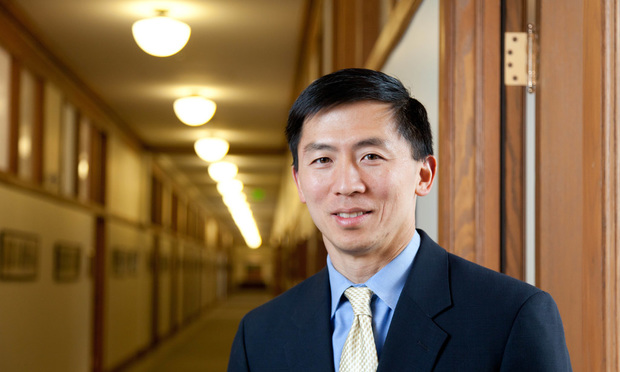Why Are Asian Americans Passing on Law School? New Report Offers Theories
A new report co-authored by California Supreme Court Justice Goodwin Liu projects that the number of Asian American lawyers in the U.S. will stagnate by 2030.
April 14, 2020 at 11:58 AM
4 minute read
 California Supreme Court Associate Justice Goodwin Liu.
California Supreme Court Associate Justice Goodwin Liu.
Without a boost in Asian American enrollment in law schools, the number of such lawyers in the United States will stagnate by 2030 after four decades of growth.
That's the key takeaway from a new article by California Supreme Court Associate Justice Goodwin Liu and two 2019 Yale Law School graduates—Miranda Li and Phillip Yao—set to appear in an upcoming edition of the University of California Davis Law Review.
The number of law students nationwide has declined 25% since the Great Recession, the paper notes, and Asian Americans have posted the single biggest enrollment decline among any racial or ethnic group in that time. That decline came despite an increase in the number of Asian Americans earning undergraduate degrees during that period. The authors theorize that Asian American students may be more influenced by economic considerations than other racial and ethnic groups, leading fewer to opt for law school.
Moreover, recent research from the Law School Admission Council found that fewer Asian American students decide to pursue law in high school or early in their undergraduate education, meaning their choices about graduate school may be more subject to current economic conditions than those in other racial and ethnic groups.
"To the extent that financial considerations become more pronounced during periods of economic stress, the greater sensitivity of Asians to such concerns may help explain the declining enrollment of Asian Americans in law school," reads the article, titled, "Who's Going to Law School? Trends in Law School Enrollment Since the Great Recession."
The new article builds on a 2017 study of Asian Americans in the legal profession by the National Asian Pacific American Bar Association and Yale Law School, which was also co-authored by Liu. That study found that the number of Asian American lawyers in the United States grew from 20,000 in 2000 to more than 50,000 in 2015. But that study also noted a dearth of Asian Americans on state and federal benches, as well as high rates of associate attrition at law firms and low ratios of Asian American partners.
For the latest study, the authors used data on law student enrollment from the American Bar Association, as well as Law School Admission Council data on law school applicants. (Those groups use different definitions for Asian American, thus their figures differ somewhat.)
The ABA numbers show that Asian American law student enrollment declined nearly 28% between 2011 and 2019, while the Law School Admission Council data put that decline at nearly 16%. The paper notes that the number of women in law school eclipsed that of men in 2016, and the modest enrollment increases of recent years are attributable entirely to more women pursuing law degrees.
The proportion of white law students has declined since 2011, along with that of Asian Americans, while black and Hispanic students have composed a larger share of the national student body over that time. However, the increase in black and Hispanic law students has largely come at lower-tier law schools, the paper notes. Women are also overrepresented at those less-prestigious schools, it adds.
In order to gauge the long-term impact of the declining proportion of Asian American law students, the authors used several models to project the combination of new lawyers joining the profession and established lawyers retiring. They conclude that the number of Asian American lawyers in the country will continue to increase until 2030 because the cohort of such lawyers who are reaching retirement is relatively small and is being replaced by newer cohorts that are significantly larger. However, that trend will plateau or decline between 2030 and 2050 without interventions to increase Asian American J.D. enrollment, the paper concludes.
Reaching out to Asian American high school students and undergraduates early in their college careers to introduce the idea of law school may be one way to reverse the slide in their J.D. enrollment, according to the paper.
"In order to reverse or mitigate current trends, civic organizations, bar associations, and law student groups, such as the National Asian Pacific American Bar Association and the National Asian Pacific American Law Students Association, may wish to consider collaborating with guidance counselors and faculty at the undergraduate and even high school levels to develop outreach strategies that inform students earlier in the educational pipeline about careers in the legal profession," the paper reads.
This content has been archived. It is available through our partners, LexisNexis® and Bloomberg Law.
To view this content, please continue to their sites.
Not a Lexis Subscriber?
Subscribe Now
Not a Bloomberg Law Subscriber?
Subscribe Now
NOT FOR REPRINT
© 2025 ALM Global, LLC, All Rights Reserved. Request academic re-use from www.copyright.com. All other uses, submit a request to [email protected]. For more information visit Asset & Logo Licensing.
You Might Like
View All
University of New Hampshire Law School Launches Specialized Health, Life Sciences Program

Supreme Court Takes Up Case Over Approval of Religious Charter School

The Week in Data Jan. 24: A Look at Legal Industry Trends by the Numbers

Trending Stories
- 1Gunderson Dettmer Opens Atlanta Office With 3 Partners From Morris Manning
- 2Decision of the Day: Court Holds Accident with Post Driver Was 'Bizarre Occurrence,' Dismisses Action Brought Under Labor Law §240
- 3Judge Recommends Disbarment for Attorney Who Plotted to Hack Judge's Email, Phone
- 4Two Wilkinson Stekloff Associates Among Victims of DC Plane Crash
- 5Two More Victims Alleged in New Sean Combs Sex Trafficking Indictment
Who Got The Work
J. Brugh Lower of Gibbons has entered an appearance for industrial equipment supplier Devco Corporation in a pending trademark infringement lawsuit. The suit, accusing the defendant of selling knock-off Graco products, was filed Dec. 18 in New Jersey District Court by Rivkin Radler on behalf of Graco Inc. and Graco Minnesota. The case, assigned to U.S. District Judge Zahid N. Quraishi, is 3:24-cv-11294, Graco Inc. et al v. Devco Corporation.
Who Got The Work
Rebecca Maller-Stein and Kent A. Yalowitz of Arnold & Porter Kaye Scholer have entered their appearances for Hanaco Venture Capital and its executives, Lior Prosor and David Frankel, in a pending securities lawsuit. The action, filed on Dec. 24 in New York Southern District Court by Zell, Aron & Co. on behalf of Goldeneye Advisors, accuses the defendants of negligently and fraudulently managing the plaintiff's $1 million investment. The case, assigned to U.S. District Judge Vernon S. Broderick, is 1:24-cv-09918, Goldeneye Advisors, LLC v. Hanaco Venture Capital, Ltd. et al.
Who Got The Work
Attorneys from A&O Shearman has stepped in as defense counsel for Toronto-Dominion Bank and other defendants in a pending securities class action. The suit, filed Dec. 11 in New York Southern District Court by Bleichmar Fonti & Auld, accuses the defendants of concealing the bank's 'pervasive' deficiencies in regards to its compliance with the Bank Secrecy Act and the quality of its anti-money laundering controls. The case, assigned to U.S. District Judge Arun Subramanian, is 1:24-cv-09445, Gonzalez v. The Toronto-Dominion Bank et al.
Who Got The Work
Crown Castle International, a Pennsylvania company providing shared communications infrastructure, has turned to Luke D. Wolf of Gordon Rees Scully Mansukhani to fend off a pending breach-of-contract lawsuit. The court action, filed Nov. 25 in Michigan Eastern District Court by Hooper Hathaway PC on behalf of The Town Residences LLC, accuses Crown Castle of failing to transfer approximately $30,000 in utility payments from T-Mobile in breach of a roof-top lease and assignment agreement. The case, assigned to U.S. District Judge Susan K. Declercq, is 2:24-cv-13131, The Town Residences LLC v. T-Mobile US, Inc. et al.
Who Got The Work
Wilfred P. Coronato and Daniel M. Schwartz of McCarter & English have stepped in as defense counsel to Electrolux Home Products Inc. in a pending product liability lawsuit. The court action, filed Nov. 26 in New York Eastern District Court by Poulos Lopiccolo PC and Nagel Rice LLP on behalf of David Stern, alleges that the defendant's refrigerators’ drawers and shelving repeatedly break and fall apart within months after purchase. The case, assigned to U.S. District Judge Joan M. Azrack, is 2:24-cv-08204, Stern v. Electrolux Home Products, Inc.
Featured Firms
Law Offices of Gary Martin Hays & Associates, P.C.
(470) 294-1674
Law Offices of Mark E. Salomone
(857) 444-6468
Smith & Hassler
(713) 739-1250








